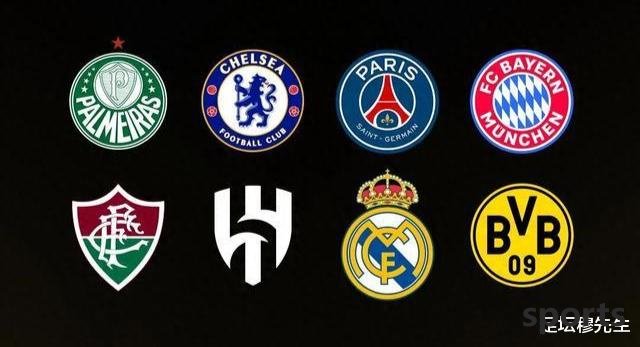There is only one World Cup in history, and the distribution of seats in the quarterfinals is exactly the same as this Club World Cup - 5 European teams, 2 South American teams, and 1 Asian team.
The World Cup has a nearly 100-year history, which is actually a history of the battle between Europe and South America. Although teams on other continents also have occasional flash moments, it depends on the stage. In the group stage, there are super unpopular things like Saudi Arabia defeating Argentina, in the quarter-finals, and there are also surprise battles like Morocco eliminated Spain. But the more you go, the less likely you will be to appear. In fact, in the past century, other teams in the World Cup have reached the semi-finals. The United States participated in the first World Cup in 1930. South Korea participated in the 2002 World Cup in Korea and Japan. Of course, it would be better not to mention this matter. Morocco has participated in the 2022 World Cup in Qatar. And in any other World Cup, the semi-finals teams, either Europe or South America, there is no trace of other teams. Basically, the Asian, African and North American teams can reach the quarterfinals, which is a rare miracle in the history of the World Cup. The reason why I came up with this topic today is of course because of the Riyadh Crescent. The revised Club World Cup is the club version of the World Cup. Although the club has foreign players, its strength and status cannot be equated with the national team, generally speaking, the gap will not be too big. Originally, many people thought that the Club World Cup would become the Champions League. But at present, the distribution of the quarterfinals is still average. The biggest surprise is of course the Riyadh Crescent, which is the glory of Asia this time. The distribution of the quarterfinals is 5 European teams (Chelsea, Paris Saint-Germain, Bayern, Real Madrid, Dortmund), 2 South American teams (Palmeiras, Fruminense), and 1 Asian team (Riyadh Crescent). There are two teams in South America shortlisted, which is not too surprising. If you benchmark against the World Cup, isn't this equivalent to Brazil and Argentina reaching the quarterfinals? This is a common phenomenon in the World Cup. Although, both clubs are from Brazil. There are 5 European teams, which is more in line with the usual pattern of the World Cup. European strong teams are already the most, and they can occupy at least half of them when they reach the quarterfinals. In fact, there are only 2010 World Cup in history, with fewer than 4 European teams in the quarterfinals. The success of Riyadh Crescent also evokes our ancient memory of the World Cup - there is only one World Cup in history, and the distribution of seats in the quarterfinals is exactly the same as this Club World Cup. That is, there are 5 in Europe, 2 in South America, and 1 in Asia. In fact, the answer is obvious. The World Cup quarterfinals are only deeply tied to one Asian team - North Korea. 1966 World Cup. The quarterfinals at that time were: Soviet Union, Hungary, Germany, Uruguay, Portugal, North Korea, England, and Argentina. Is the configuration of this continent the same as this Club World Cup? Riyadh Crescent is definitely against North Korea, while Uruguay and Argentina are against Palmeiras and Fruminense. Unfortunately, in that World Cup, Brazil suffered a Waterloo in the group stage and failed to advance. It is difficult for European teams to compete, and it is a bit unreliable. Speaking of that World Cup, some European teams have not yet begun, such as the Netherlands, France, and Spain. The Soviet Union and Hungary were all great teams from ancient times. Now they either no longer exist or have become second-rate. Of course, in that World Cup, the quarterfinals were just the first round of the knockout round. After all, the World Cup was small at that time, with only 16 teams. However, North Korea's counterattack posture is like the current Riyadh crescent moon. The difference is that North Korea was eliminated by European teams, while Riyadh Crescent has to face the test of a South American team. If they can pass this level, they will continue to test each other with the European giants. Now it depends on whether Riyadh Crescent can enter the semi-finals. 
- Recent Posts
-
- Superstition? Archerby wears b
- Milan sells player transfer fe
- Down 10 million! German transf
- TA: Newcastle is pushing to re
- Reporter: Leeds United offers
- Atletico Madrid officially ann
- Brazilian media: Ancelotti tak
- Football Today Middlesbrough V
- Yitian: Naples opens 16 millio
- Italian League: Juventus wins
- Hot Posts
-
- The 2025 "Governor s Cup" Jian
- Five champions missed the Club
- Ziwo’s silent changes compared
- Recommended Sunday: Salzburg v
- Guangsha entered the quarterfi
- Zheng Qinwen-Wenfa Open went s
- Bloody! 1-4 behind in the fina
- Football Preview: Palmela vs C
- The Chinese U19 Men s Basketba
- Bellingham Jr. was suspended f
- Club World Cup: Real Madrid is
- Club World Cup Finals: The Blu
- Bergomi: Veteran Dzeko will st
- La Liga situation: 3 major sus
- The decisive game beat the Eur
- "Marte Night" scored Mancheste
- Four Premier League games are
- Benefits of 100 million euros!
- Two top European clubs target
- How difficult is it for Asian
- search
-
- Links
-
